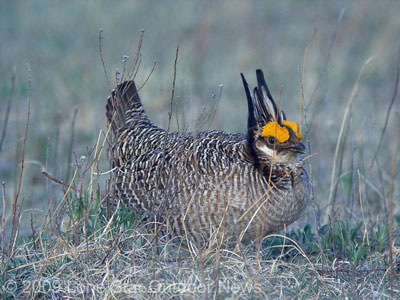 Lesser prairie-chickens could be doing better than expected, especially in northern portions of its range, after a brutal year of drought.
Lesser prairie-chickens could be doing better than expected, especially in northern portions of its range, after a brutal year of drought.
The first range-wide aerial survey to assess lesser prairie-chicken populations across portions of five states this spring detected several previously unknown breeding areas, known as leks, despite severe drought across the region last year. Survey teams also detected leks in Kansas beyond what was thought to be the northern extent of the bird’s historic range.
Although complete results won’t be tallied until later this summer, the survey data could be important as the U.S. Fish and Wildlife Service considers whether to list the lesser prairie-chicken under the federal Endangered Species Act.
The Lesser Prairie-Chicken Interstate Working Group, composed of biologists from Texas Parks and Wildlife Department and the other state fish and wildlife agencies of New Mexico, Oklahoma, Kansas and Colorado, collaborated with federal agencies and West Ecosystems, Inc. of Laramie, WY in this first effort to conduct a large-scale, helicopter-based survey to locate lesser prairie-chicken leks across the High Plains region in all five states.
Leks, which are also referred to as booming grounds, are sites that the birds come to every spring for breeding. The surveys encompassed more than 300,000 square miles and the results will be used to produce the first ever statistically valid, five-state estimate of the number of leks and the total population of birds later this summer.
“These surveys will be the basis of a range-wide management plan for lesser prairie-chickens that is in development by the five states in collaboration with the Western Association of Fish and Wildlife Agencies Grassland Initiative. The plan is expected to be completed by next March, and may help avoid the need for US Fish and Wildlife Service to designate the lesser prairie-chicken as a federally threatened or endangered species,” said Sean Kyle, Texas Parks and Wildlife biologist and working group chair.
Lesser prairie-chicken numbers have been largely increasing in Kansas for the last 15 years, while populations have declined in parts of the southern portion of the range. Some biologists believe this northward expansion may represent a shift in the population of the species caused by climatic conditions associated with changing precipitation patterns.
The lesser prairie-chicken has been considered a candidate under the Endangered Species Act since 1998, and U.S. Fish and Wildlife Service has indicated it will release a proposed rule on the status of the bird for public comment this fall. Information from surveys will be used as a baseline by the state fish and wildlife agencies to monitor trends in prairie-chicken populations and to target conservation programs in partnership with private landowners, oil and gas industries, wind energy, and electric utilities.
To help restore habitat for the bird, state and federal experts developed a tool called Candidate Conservation Agreement with Assurances (CCAA) to work with private landowners and managers in the geographic range of the lesser prairie-chicken. This voluntary program was designed to help reverse the current declining trend in lesser prairie chicken numbers by promoting habitat conservation and restoration through various management practices such as prescribed grazing, upland wildlife habitat management, brush management, prescribed burning, range planting and restoration and management of rare or declining habitats. The program also provides assurances to landowners that, beyond what is detailed in the CCAA agreement, they will not be required to meet any new regulations if the bird is listed under the Endangered Species Act.
Texas agriculture producers may sign up to manage and restore high-priority habitats for the lesser prairie chicken within the eligible Texas counties, including: Ochiltree, Lipscomb, Roberts, Hemphill, Gray, Wheeler, Donley, Collingsworth, Deaf Smith, Parmer, Bailey, Lamb, Cochran, Hockley, Yoakum, Terry, Andrews, Gaines and Oldham.
Landowners can get details regarding the lesser prairie-chicken CCAA by contacting TPWD Biologist Jeff Bonner at 806-665-3494 or Manuel DeLeon at the U.S. Department of Agriculture Zone office in Lubbock at (806) 791-0581. Or visit the NRCS website at http://www.tx.nrcs.usda.gov/programs.

